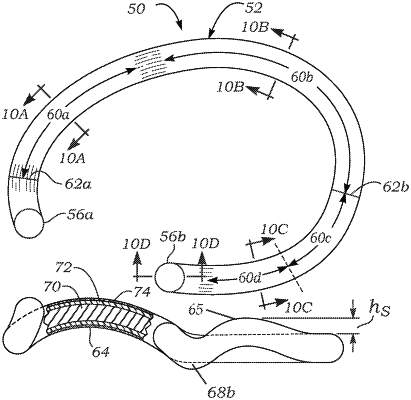| CPC A61F 2/2448 (2013.01) [A61F 2/2442 (2013.01); A61F 2/2445 (2013.01); A61F 2250/0018 (2013.01); A61F 2250/0019 (2013.01)] | 20 Claims |

|
1. A method of repairing a native tricuspid annulus of a heart with a physiologically harmonized tricuspid annuloplasty ring, the tricuspid annulus defining a periphery as seen looking at an inflow side that has an asymmetric ovoid shape including the following anatomical landmarks as seen in series in a clockwise direction: an antero-septal commissure, an anterior leaflet on an anterior side, an antero-posterior commissure, a posterior leaflet on a posterior side, a postero-septal commissure, and a septal leaflet on a septal side, the tricuspid annulus further having a long dimension extending approximately from the antero-septal commissure to the postero-septal commissure with the septal leaflet extending therebetween, and wherein the septal leaflet is located radially inward of electrical structure of the heart including an atrioventricular node (AV node) and a bundle of His extending clockwise from the AV node, the method comprising:
advancing a tricuspid annuloplasty ring to the tricuspid annulus, the tricuspid annuloplasty ring having an inner core made of a relatively rigid material surrounded by a suture-permeable outer cover that conforms to the inner core, the inner core defining a central open area and defining a peripheral plan view shape lying partially in a plane and having an inflow side and an outflow side, wherein the plan view shape as seen looking at the inflow side has an asymmetric entirely outwardly convex ovoid open ring shape from a first free end extending clockwise to a second free end, the free ends being separated by a gap, and the outer cover having thereon a pair of commissure markers, wherein the first and second free ends are each bent into bends in the inflow direction from the plane at an angle θ of between 45°-90°, and wherein the cross-section of the inner core at the first and second free ends is such that the inner core is stiffer adjacent the first free end than adjacent the second free end, and the inner core has a varying flexibility that gradually becomes more flexible in a direction extending from the first free end to the second free end;
registering the commissure markers with the antero-septal commissure and the postero-septal commissure, respectively, such that the first free end extends counter-clockwise from the antero-septal commissure and the second free end extends clockwise from the postero-septal commissure, the second free end avoiding extending as far as the AV node; and
suturing the tricuspid annuloplasty ring to the tricuspid annulus.
|